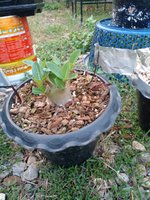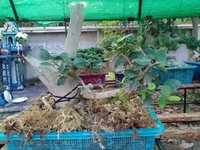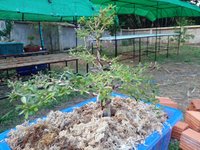Hey how are you? Im planning on growing a couple of juniper and black pines pre-bonsai on colander in order to thicken the trunk. The question is what soil particles size would you say works best with the colander for this purpose: smaller? or better large ones. What im planning on using would be mainly lava and pumice. Any other recomendation would be gladly apreciated. Thanks!
You are using an out of date browser. It may not display this or other websites correctly.
You should upgrade or use an alternative browser.
You should upgrade or use an alternative browser.
Soil particle size for colander planting
- Thread starter maxajax
- Start date
dirk hoorelbeke
Omono
I'm not convinced you will have benefit in trunk growth with junipers in colander. For pines i use the medium size. Even in colanders using too small particle sizes will have a bad effect.
Leo in N E Illinois
The Professor
- Messages
- 11,341
- Reaction score
- 23,294
- USDA Zone
- 5b
Regardless the container, regardless the media choices, the more uniform your particle size the more air and water the mix will hold, the healthier the roots will be. Key is to eliminate fines, and eliminate coarse grains. A uniform particle size is perfect.
For a colander the mix should be coarse enough that it does not fall through the holes in the colander. This will usually be a medium or a coarse mix.
I agree with Dirk, colanders are best used to force creation of fine branched root systems. They are not necessarily good for getting rapid growth to bulk up size of a tree. A colander will give you slower growth than conventional containers of the same size.
For a colander the mix should be coarse enough that it does not fall through the holes in the colander. This will usually be a medium or a coarse mix.
I agree with Dirk, colanders are best used to force creation of fine branched root systems. They are not necessarily good for getting rapid growth to bulk up size of a tree. A colander will give you slower growth than conventional containers of the same size.
0soyoung
Imperial Masterpiece
. Bigger particles do not reduce the AFP of the smaller sized substrate.Key is to eliminate fines,and eliminate coarse grains.
... unless one waters more frequently. There is a larger evaporative surface area in a colander, pond basket, and the like, than a conventional pot or buried in the ground. Studies almost always water all experiment groups uniformly.A colander will give you slower growth than conventional containers of the same size.
... not to pick on you, personally, Leo.
Lannabulls
Yamadori
I am reserching, learning about soil particles sizes, that is why I am here answering this dated thread.Regardless the container, regardless the media choices, the more uniform your particle size the more air and water the mix will hold, the healthier the roots will be. Key is to eliminate fines, and eliminate coarse grains. A uniform particle size is perfect.
For a colander the mix should be coarse enough that it does not fall through the holes in the colander. This will usually be a medium or a coarse mix.
I agree with Dirk, colanders are best used to force creation of fine branched root systems. They are not necessarily good for getting rapid growth to bulk up size of a tree. A colander will give you slower growth than conventional containers of the same size.
Why colander gives slower growth than convencional pot?
Thanks
MaciekA
Shohin
I am reserching, learning about soil particles sizes, that is why I am here answering this dated thread.
Why colander gives slower growth than convencional pot?
Thanks
It doesn't yield slower growth in and of itself, primarily because collander growing isn't just a matter of putting a tree into an 8" thunder group basket and calling it good.
Collander growing has a few other practices associated with it, namely more frequent watering (and perhaps fertilizing too).
Colander growing is just part of a wider set of ideas around growing in high air flow or root-escape friendly containers that are either entirely mesh construction (baskets) or have a mesh bottom (anderson flats and similar). The high air flow properties of these types of containers have many other implications and tradeoffs besides simply the ability to grow fast.
Also, mesh containers and baskets can be stacked on top of grow beds or gravel or on top of other baskets for additional root escape (while continuing to constrain the root system somewhat within the first basket). Stacking containers regains some of the root lengthening properties of ground growing while retaining some portability and root monitoring capabilities. Search for Kazuo Onuma's growing methods and instagram account to see numerous examples of this (and take notice of what soil he's using -- pure lava -- imagine how often he can water).
Container and soil choice is ultimately all about tradeoffs and some of those tradeoffs end up requiring the grower to expend more effort to gain benefits. If I had to take long vacations in the summer, collanders would perhaps not be a wise choice for me. But I already live at the same place where I'd vacation at, so I don't mind the higher watering requirements of colanders, especially given the results.
Side note, if growing wood as fast as possible was your one and only goal, you can likely grow (say) a pine much faster in a tall, skinny black plastic nursery pot filled with bark bits, or you could straight up grow in unrestricted ground (sans grow bag, no constraint whatsoever), but that wouldn't yield a result that's as useful for bonsai, it would be more for landscape or timber purposes. A tree grown that way would require additional significant timeline-impacting steps to guide the root system back towards growing a bonsai-shaped root system for bonsai. When contrasted against unrestricted or tall nursery can growing, you can see that colander growing doesn't just aim at one goal, it tries to balance several goals at once. I'm not an authority, but I can say that it's very compelling that those who use colander growing are often professionals who are trying to race nice stubby trunks to market as fast as possible, toil of watering be damned. I doubt it's a coincidence.
Tradeoffs are everywhere in bonsai. If you can, compare and see what works for you, your climate, your species. See what others in your area are having success with. In Thailand, as far as I know, you have a hot humid environment which in places can be rain heavy. Such an environment might be good for colander growing, especially if you are trying to grow certain conifers that like it on the drier side.
Leo in N E Illinois
The Professor
- Messages
- 11,341
- Reaction score
- 23,294
- USDA Zone
- 5b
@Lannabulls - You are in Thailand. Your climate is quite warm, 40 C for several months is normal. The comments about colanders from @MaciekA - are from northwestern Oregon, a mild climate that rarely is colder than 4 C and rarely warmer than 27 C. The Oregon climate is quite mild, compared to your climate in Thailand. The use of colanders in Thailand should be experimented with the understanding that the Thai dry season is quite a bit hotter, and less rain than the corresponding dry season in Oregon.
Just a note of caution. Colanders are great if the watering frequency can be worked out. Start with just a few. See how quickly they go from wet to dry in your climate.
Just a note of caution. Colanders are great if the watering frequency can be worked out. Start with just a few. See how quickly they go from wet to dry in your climate.
Lannabulls
Yamadori
Thanks so much Leo,
Here temp are increasing, we are going into hot season and your consideration is completely right. Care colanders in hot season here is challenging. Fortunately I dont have to go office for work everyday, I work in the same place were my bonsai are, I can watering them everytime needed. In top of that I built a full automaze water spray system to keep humidity in range.
Let see in may how bad will be.
Thanks!
Here temp are increasing, we are going into hot season and your consideration is completely right. Care colanders in hot season here is challenging. Fortunately I dont have to go office for work everyday, I work in the same place were my bonsai are, I can watering them everytime needed. In top of that I built a full automaze water spray system to keep humidity in range.
Let see in may how bad will be.
Thanks!
Frozentreehugger
Masterpiece
I live in Canada about as opposite a climate As is possible from you In Thailand . Just very curious what plants do you grow as bonsai . Post some pictures . I’ve seen some incredible pottery from there . Do you grow plants native from there . I’m very sure others would be very interested .Thanks so much Leo,
Here temp are increasing, we are going into hot season and your consideration is completely right. Care colanders in hot season here is challenging. Fortunately I dont have to go office for work everyday, I work in the same place were my bonsai are, I can watering them everytime needed. In top of that I built a full automaze water spray system to keep humidity in range.
Let see in may how bad will be.
Thanks!
Lannabulls
Yamadori
Going to take some photos, however dont expect much, I am just a bonsai rookie and most of my bonsai are in prebonsai stage.
In the main time species that I' m growing and learning the art:
some juniper nana, golden juniper, black pine, japanise elm.
About native and tropical species:
Tamarind, buganvilla, adenium, linh sam, carmona "funkien tea", coconut, bush cherry and some others native of Thailand as well that dont even have an english name.
The one that I struggle most is buganvilla, she really "heates" water, still leraning how to proper watering.
In the main time species that I' m growing and learning the art:
some juniper nana, golden juniper, black pine, japanise elm.
About native and tropical species:
Tamarind, buganvilla, adenium, linh sam, carmona "funkien tea", coconut, bush cherry and some others native of Thailand as well that dont even have an english name.
The one that I struggle most is buganvilla, she really "heates" water, still leraning how to proper watering.
Lannabulls
Yamadori
Lannabulls
Yamadori
Lannabulls
Yamadori
Lannabulls
Yamadori
Lannabulls
Yamadori
This species is tipical from center Thailand, name in english dosent exist, we call him "ดอกปลาหมอ บอนไซ" "dok plamo" I just traied to spell the sound, probably it isent correct, I can speak thai, I cant read and write, I am italian.
Evergreen, leaves turn red in winter, and again green now when hot season begins.

Evergreen, leaves turn red in winter, and again green now when hot season begins.

Lannabulls
Yamadori
Frozentreehugger
Masterpiece
You have some nice material. I like the native plants Don’t be shy about posting pics . A lot of us will find not common trees we see fascinating . Plus I don’t grow Tropicals . But a lot of experienced people here do. I’m sure you can get advice if you have problems even in the cold parts of the world . They are grown indoors or green houses . Your off to a great start 

Lannabulls
Yamadori
Thanks so much!You have some nice material. I like the native plants Don’t be shy about posting pics . A lot of us will find not common trees we see fascinating . Plus I don’t grow Tropicals . But a lot of experienced people here do. I’m sure you can get advice if you have problems even in the cold parts of the world . They are grown indoors or green houses . Your off to a great start
You are 100% right my friend, here I got the best, quick advises ever and I am very greatfl to all you guys, thanks so much!
Frozentreehugger
Masterpiece
We are all in the same asylum my friend . Remember there is tropical bonsai people all over the world. That would love to have access to the plants and growing conditions you have . Don’t be hesitant. To discuss anything . There is some real expertise here .
Take care
Take care
I love seeing the different tree species from around the world. I recently did a hike through El Yunque rainforest in Puerto Rico and my guide was getting into bonsai as well. We ended up going for beers and exchanging information about species the other will probably never get to work with. Needless to say, the way he cares for his tropical trees in Puerto Rico are totally different than what I'm doing here in NY as are the species for the most part. It was actually amusing to hear someone say he's envious of the cold weather in NY (he must have had too many beers).This species is tipical from center Thailand
Similar threads
- Replies
- 6
- Views
- 2K
- Replies
- 11
- Views
- 2K
- Replies
- 22
- Views
- 4K







